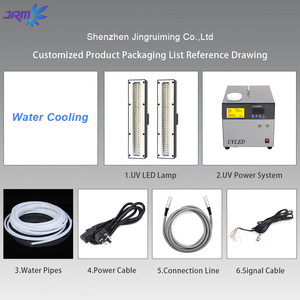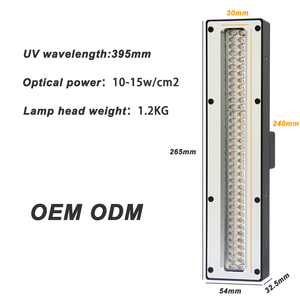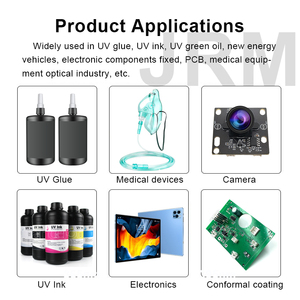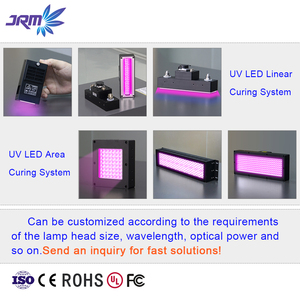
All categories
Featured selections
Trade Assurance
Buyer Central
Help Center
Get the app
Become a supplier

(1001 products available)














































The 365nm UV LED array curing light comes in various types and designs depending on the intended application. Here are some common types:
Handheld Curing Lights
These are portable devices designed for professional and at-home use. They are usually lightweight and easy to use. They need to be plugged in or have a rechargeable battery. Handheld curing lights are widely used in salons and for personal use.
Led Nail Lamps
These are specifically designed to cure UV gel nail polish. They come as dual-wavelength lamps with 365nm and 405nm. Dual-wavelength LED lamps cure gel polish faster than single-wavelength lamps. They are available in various designs, including; U-shape, open design, enclosed designs, and portable designs. Enclosed designs are ideal for salons, while portable designs are suitable for at-home use.
Smart Curing Lights
These curing lights have smart features. For instance, built-in sensors that automatically switch on/off when hands are inserted or removed. They come with adjustable intensity settings and timers. Some have LCD screens that display the curing process. They are popular in salons due to their advanced features and ease of use.
Compact LED Curing Lights
These lights are small and lightweight. They take up little space and are ideal for people with small workspaces. Despite their size, they are powerful and can cure various UV gels. They are mainly used in professional settings.
Tabletop LED Curing Lights
These lights are larger and designed for stationary use. They are placed on a table or workstation. Tabletop LED curing lights are powerful, come with multiple LED arrays, and have advanced features. They are ideal for busy salons and can accommodate many clients.
Dental LED Curing Lights
These curing lights are specially designed for dental applications. They are used to cure dental composites during restorative treatments. Dental LED curing lights are lightweight, portable, and easy to use.
Industrial LED Curing Lights
These are high-powered curing lights designed for industrial use. They provide fast and efficient curing of various materials, including adhesives, coatings, and composites. They are more expensive and consume more power than other curing lights.
While UV light curing is a popular and effective way to quickly dry certain materials, it is important to consider the risks involved with its use. UV lights can damage skin and eyes, so protective gear should be worn when using them. The array curing lights also need to be handled with care to avoid burns. They can reach high temperatures when used for extended periods of time.
That said, here are the features and functions of UV LED light curing arrays:
LEDs
LEDs are the main component of an LED curing light. They produce light that activates the photoinitiators in the materials used. The LED array generates light that is focused and directed onto the surface that needs curing.
Heat management
The heat generated by the LED curing light needs to be managed. Curing lights have heat sinks that absorb and dissipate heat. Some lights have active cooling systems to control the temperatures. Managing heat is important because excessive heat can damage the LEDs and the materials being cured.
Power supply
The power supply provides electrical power to the LED array. It is responsible for generating the UV light that cures the materials used. Power supplies come in different configurations, such as constant voltage and constant current.
Optics
Optics in LED curing lights control and direct the light output. They increase the efficiency of the light output by reflecting and focusing the light produced by the LED array. Some curing lights have removable optics to make maintenance easy.
Housing
The housing is the casing of the LED light curing array. It protects the internal components from damage. The housing also dissipates heat and provides structural integrity to the curing light. It is usually made with materials that can withstand high temperatures, such as aluminum.
Control unit
The control unit is an important component of an LED array curing light. It controls the operation, intensity and curing time of the light. The control unit has a user interface. It allows users to control and adjust the settings of the curing light according to their needs.
The 365nm UV LED array curing light has a variety of applications across different industries. Here are some common usage scenarios:
Nail salons
Nail salons use LED curing lights to accelerate the drying and hardening process of gel polishes. The 365nm wavelength LED lights activate the gel's photo initiators, resulting in a smooth, long-lasting manicure. LED lights are more popular in nail salons than UV lights because they are safe and do not damage the skin. Also, LED lights are specific to gel nail products, making them more effective than UV lights.
Cosmetic industry
The cosmetic industry uses LED curing lights to dry and cure various products, such as eyelash adhesives and gel-based makeup. The use of LED lights provides a quick turnaround time, allowing makeup artists and technicians to complete tasks efficiently. Additionally, using LED lights in the cosmetic industry helps to prevent skin damage from prolonged UV exposure.
Dental clinics
Dentists use LED curing lights to harden dental resins and sealants. The LED lights provide quick curing times, which helps to reduce the overall time spent by patients in the dentist's office. Additionally, the use of LED lights ensures that the dental resins achieve optimal bond strength, resulting in durable dental repairs.
Electronics manufacturing
Electronics manufacturers use LED curing lights to cure conformal coatings on circuit boards. The conformal coatings provide protection to the circuit boards from moisture, dust, and other environmental contaminants. Using LED lights in electronics manufacturing helps to improve the efficiency of the production process and results in reliable coatings.
Adhesive bonding
LED curing lights are used to cure and create strong bonds between different materials, such as glass, plastics, or metal. The use of LED lights provides quick curing times, allowing manufacturers to work with a variety of substrates efficiently. Additionally, using LED lights to bond materials results in durable and transparent bonds that are aesthetically pleasing.
Art and Restoration
LED curing lights are used in art and restoration to cure UV-resistant varnishes and adhesives. Using LED lights ensures that the original artwork is preserved, as UV light does not cause damage to the materials used. Additionally, LED lights provide a quick curing time, which is beneficial for restoration projects that require immediate results.
When choosing the right LED light for UV curing, consider the following factors:
Consider the Type of Material to Be Cured
The first step is to determine the type of material that needs to be cured. Different materials require different wavelengths for curing. For instance, 365nm is ideal for curing adhesives, coatings, and inks that are specifically formulated to work with this wavelength. These materials are commonly used in the automotive, electronics, and printing industries.
Consider the LED Array Configuration
The LED configuration plays a crucial role in the curing process. An array configuration provides a more uniform light output, which results in consistent curing. On the other hand, a single LED may be suitable for targeted curing applications. Buyers should analyze their curing needs to determine the array's optimal size and configuration.
Taking into Account the Curing Time
Curing time is a critical factor in determining the efficiency of the curing process. LED lights with higher intensities will reduce curing times, increasing productivity. When purchasing LED curing lights, it's important to consider the required curing time for the specific application to ensure the light has the appropriate intensity.
Considering the Distance to the Cured Surface
The distance between the LED light source and the surface to be cured can affect the intensity of the light. The intensity decreases as the distance increases. Therefore, when choosing a light source, it's important to consider the distance to ensure adequate intensity for effective curing.
Assessing the Power Supply
The power supply is important when choosing LED lights. LED lights require a specific power supply to function optimally. Therefore, it's important to assess the power supply to ensure it meets the requirements of the chosen LED light. This also ensures the light operates efficiently and has a longer lifespan.
Q1: What are the benefits of using UV LED lights for curing?
A1: UV LED lights have several advantages over traditional mercury lamps. They only emit UV light at specific wavelengths, which makes them safer to use because no harmful ozone is produced. Curing times are also faster, and UV LED lights have longer lifespans and lower energy consumption.
Q2: What are some applications of UV LED curing lights?
A2: UV LED curing lights are used in various industries, including electronics, automotive, printing, medical devices, adhesives, and coatings. They are used to cure or dry UV-sensitive inks, adhesives, and coatings to create a permanent bond or finish.
Q3: How do UV LED curing lights work?
A3: UV LED curing lights work by emitting UV light at specific wavelengths. When UV-sensitive materials are exposed to these lights, a photochemical reaction occurs that causes the material to cure or dry. The reaction is used to create a permanent bond or finish.
Q4: Are UV LED curing lights safe to use?
A4: UV LED curing lights are safe to use when proper precautions are taken. Users should protect their skin and eyes from direct exposure to UV light. Some UV-sensitive materials may cause skin irritation, so it is important to follow the manufacturer's guidelines and safety recommendations.